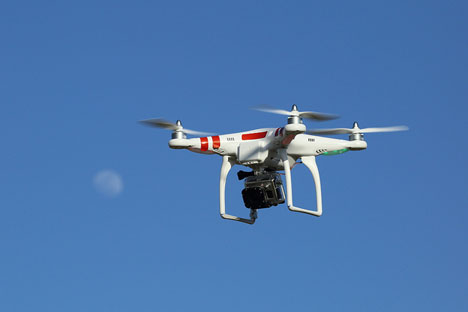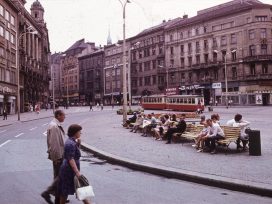
Writing is a known tool for healing trauma. And poetry lends itself to rapid responses under pressure. Forced into migrating to flee war, many Ukrainian women turn to the short form as a call of solidarity, a weapon and solace.
In the age of Google Earth and the Human Genome Project, tensions between information processed by machines and the human capacity to tell stories have intensified. Ragnild Lome traces the evolution of these tensions in literary and visual culture from the mid-twentieth century onward.
As we examine the screen, the first thing we look for is movement. Green fields divided up by bluish lines. Isn’t there something moving in the blue? After a while, the motif shifts. Our eyes scan, try to find a logic in the patterns. For around five minutes, different aerial views appear – apparently filmed by drones – of what we later learn is a swamp landscape in Andalucia, filmed from just far enough away for the dry land to look as if it is painted in oils but near enough for the movements to be visible. Then we are sent down to ground level.
These are the opening images in Alberto Rodriguez’s crime thriller, La Isla Mínima (Marshland, 2014). Two Spanish policemen, one young (brought up in democratic Spain) and one older (brought up under Franco) must work together to investigate the disappearance of two young girls. They are not seasoned partners; we learn that they scarcely know each other and that both of them have been assigned to Andalucia because of conflicts with head office in Madrid. This, along with the historical backdrop – the film’s action unfolds five years after the death of Franco – creates an expectation that the heroes are not wholly good.
In an average detective series, the objects found during the investigation aren’t just pieces in the puzzle, they also take on the role of co-narrators: the clothes in the ditch reveal something essential about the perpetrator’s habits or weaknesses. The contents of the rubbish bin give away what the owner likes to do in bed. During the course of the nineteenth and twentieth centuries, material objects were fetishized, says literary researcher Mark Seltzer, in his book Bodies and Machines (1992). Science creates and refines models on paper and in databases, so that it ultimately seems as if things themselves – magically and without human intervention – turn themselves into numbers that our machines can read. In Rodriguez’s film, the objects are mute. Pieces of evidence are at hand which, with today’s technology, could have revealed the perpetrator in the blink of an eye. However, they are investigated by the police in the field, not by experts in laboratories. The detectives themselves must put two and two together – and they constantly get it wrong. Things do not yet speak by themselves.

Drone, with the moon in the background; April 2013. Photo: Don McCullough. Source: Flickr
Almost 60 years ago, Hannah Arendt asserted that we had achieved the age-old dream of finding the Archimedean point, satisfied the desire to view Earth from above, conquered the heavens and beyond “to reach into space, in the neighbourhood of the sun, the moon and the stars”, as she writes in the opening comments of her philosophical magnum opus, The Human Condition (1957). “The Archimedean point” is the term used in Greek antiquity for the idea that mankind could lift the entire Earth if only it were possible to place a lever at a great enough distance. This point has since become synonymous with a neutral standpoint, a perspective that enables us to exclude ourselves from the equation: at the Archimedean point, it only requires a single gaze in order to read the whole world. While this ideal was abandoned long ago in philosophical discussion, it is alive and well in tools such as Google Earth and in research projects such as the Human Genome Project; we have found the Archimedean point and begun to organize the world from there.
Reading Arendt’s observations of 1957 today, it is easy to forget that mankind had not yet entered space; that Uri Gagarin’s ice-cold trip around the Earth and back again in 1961 was still to come. However, the gaze Arendt is talking about belongs to the machines: it is the machines that found the Archimedean point.
The German saying, if one goes on a journey, one has something to tell, serves as the fulcrum for Water Benjamin’s essay “The Storyteller” (1937). The saying, writes Benjamin, is no longer applicable. The machine does not tell us about its journey, but produces information, maps, conveys a cybernetic swarm of figures and codes from one machine to another. Information is distinct from stories, which circulate among people and acquire their rhythm from physical labour; they are preserved and kept warm in the heads of people who use their bodies to carry out tasks. Stories circulate around campfires, writes Benjamin, or while people knit or felt or pick potatoes. A story can stretch for entire working shifts, hours on end pass while the human body is at labour, ears pricked up. Information, on the other hand, is stored in the machine’s circuit.
It is not that machines prevent us from telling stories – Benjamin does not formulate a banal critique of technology; rather, storytelling is no longer kept alive in the situation in which mankind finds itself. The working rhythm has altered: now we work to the monotonous rhythm of machines rather than the slow turning of the Earth and the coming and going of daylight. What’s more, the story’s most important source – distance – has vanished. In part, this is attributable to the arrival of machines. They travel for us and can travel to places that mankind alone can only dream of reaching. But they also convey better, more usefully; they come home with material we can use, not just individual experience. Even Gagarin, the Russian who travelled further than anybody had ever travelled before, had his story hijacked by machines, which had gathered material more convincing than anything he could tell. The machines placed information like dislodged stars over a winter landscape. Or at least this is how it appears in Lotta Lotass’s novel about Gagarin’s space journey, Third Flight Speed (2004). In a series of montages, Lotass weaves together the myths about the Russian cosmonaut and dreams about his journey in space. It is as if Gagarin is unable to tell the tale himself but is in a vacuum, rotating around his own story. The fulcrum is the freezing cold, the only thing that links Gagarin’s personal story to the journey in space.
Even if someone still wants to tell stories, nobody wants to listen any more. In an episode of the American TV series Big Bang Theory (2007-), Howard, the engineer, has been on a trip to the international space station, ISS, to fix a toilet. Back home, he’s keen to tell everybody about his experience. At the start of the episode, he won’t let a single opportunity go by without mentioning the journey or telling a little anecdote about his workplace up on high. He irritates both girlfriend and friends, and throughout the episode, they all try to make it clear to the former astronaut how single-minded he is. At the end of the episode, the penny drops when Howard is shown a YouTube video of some children trick-or-treating Buzz Aldrin, the second man on the moon. Aldrin opens the door and gives them chocolates with suitably cosmic names – a Mars Bar, a Moon Pie – and adds, like a public service announcement for the younger generations, who aren’t remotely interested: “You know, I went to the moon!”
*
Alain Robbe-Grillet’s films and novels acquire their energy from the desire to map, to lift things into the light and to describe them in unbearably long takes and passages of text. The novel Jealousy came out in 1957, the same year the Americans were caught by surprise at how far the Russians had come in the Space Race. Set on a tropical plantation, where the heat is exhausting, the story is narrated in first or third person singular; though it’s not easy to determine which, as the pronoun “I” is never used. The main character sits in a house, looking out at the veranda where his wife and friend sit. The whole book is narrated in the present. Neither past nor future are mentioned, only the present action and spatial presence. At no point in the novel does the narrator move to take part in or find out what is happening out there on the veranda; all the information is channelled via the gaze, a gaze that employs a geometrical vocabulary to describe what it sees. The hairbrush is “like a bone-coloured oval” and moves “in a rapid curve” over the hair, while “the window opening [is split] into three equally high and almost equally broad fields”. The importance of using the correct description is continually emphasized; the anxiety about missing something out there on the veranda overshadows everything.
Robbe-Grillet’s language mimics a formalized language that is continually falling apart, making mistakes, is incapable of systematizing its observations; as soon as an attempt is made to convert reality into information that can be categorized, it appears absurd and unreadable. As the “plot” gradually advances, the reader becomes increasingly convinced that the narrator’s gaze is incapable of describing anything at all, that we are witnessing a panicked and mechanical tour de force, with a narrative subject that spreads out with every turn of the page. Robbe-Grillet brings the Archimedean point down to earth and places it inside a house; staring out onto the veranda, the gaze is in no position to investigate or do anything other than just that: stare. Something can always be read from the movements and the placement of the lemonade glasses out there on the veranda.
Most of Rodriguez’s La isla minima is told with low-set cameras, at eye-level with the characters – in striking contrast to the introductory aerial images at the start of the film. People wander around among high reeds, chest-high in water, or drive along stretches of road with little side-tracks to the left or right that are unmarked on the map the policemen use to find their way. When the gaze is raised up to a height of kilometres towards the end of the film, it is not to provide a perspective of the landscape that shows where the bad guy’s car was driving or to give the public the overview they are looking for: the possibility of being able to read the signs better than the people themselves. Instead, the drone’s perspective offers us a quiet, beautiful image of the dry land, detached from human affairs, without any promises of catharsis or solutions to burning moral dilemmas. The drone climbs coolly up from the scene of the crime, giving us a hard-to-read pattern to take home with us.
The English translation was funded by Fritt Ord.
Published 8 February 2016
Original in Norwegian
Translated by
Lucy Moffatt
First published by Vagant 3/2015 (Norwegian and English versions)
Contributed by Vagant © Ragnild Lome / Vagant / Eurozine
PDF/PRINTSubscribe to know what’s worth thinking about.

Writing is a known tool for healing trauma. And poetry lends itself to rapid responses under pressure. Forced into migrating to flee war, many Ukrainian women turn to the short form as a call of solidarity, a weapon and solace.

Until almost the very end, Milan Kundera refused to let his work be translated into Czech or Slovak. Now that is changing, he is being rediscovered by a new generation. Although his wish to return was unfulfilled, his work is experiencing a homecoming.